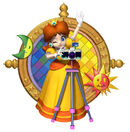| "We're still missing something. Oh yeah—infobox!" | |
|---|---|

|
This article is missing an infobox. You may remove this template once an infobox has been added to the article. |
Classic Mode is a mode featured in every installment of the Super Smash Bros. series. Before starting, the player has to select a fighter, the number of stock (ranging from 1–5), and the difficulty setting. The goal is for the fighter to progress through a series of VS matches and win in each of them.
Classic Mode has received major changes between each of its appearances while maintaining a few consistencies throughout. The matches are often randomized by character, stage, or battle type, usually depending on their accessibility order or the character being played as. Most installments feature a few playable bonus stages, such as Target Smash!, partway through. The final battle is against Master Hand, as well as Crazy Hand in higher difficulty settings of most games.
History[]
In Super Smash Bros., the mode is named 1P Game. The stages and opponents are always accessed in a consistent order, unlike later titles. The ninth stage features a battle against Metal Mario on a unique stage, Meta Crystal.
In Super Smash Bros. Melee, the mode is named Classic. While the characters and stages are now randomized, a structure is still maintained, such as how Snag the Trophies is always the sixth stage accessed. The opponent fighters are always fought on a specific stage representing their franchise (e.g. Mario is fought at either Princess Peach's Castle or on Rainbow Cruise, both represented by the Mario franchise). While there is still a Metal battle, the scripted fight against Metal Mario instead takes place in the Adventure mode. By completing Classic, the player can earn a trophy of the fighter that they specifically played as.
In Super Smash Bros. Brawl, Classic Mode's layout is randomized per franchise (e.g. a Yoshi or a Donkey Kong battle always occurs on stage 2).
In Super Smash Bros. for Nintendo 3DS, Classic Mode has a basic overworld where the player's fighter moves on a straight path to a fighter before the battle starts. The main path branches off into three paths, colored red, green, and blue. Each red path leads to a battle with the highest difficulty setting but rewards the most coins, and each blue path has the lowest difficulty setting and rewards the least amount of coins. Aside from being color-coded, each diverged path is marked by a franchise symbol, which indicates that the fighter and stage are represented by that specific franchise.
In Super Smash Bros. for Wii U, Classic is set up like a tournament, and while the game randomly selects the fighters, one can see whom they can fight before starting the battle (and a faint preview of the stage where the battle occurs is shown beneath them). The opponent and stage are not always from the same series, even in single-opponent battles (e.g. there's a possibility of fighting Mario on a The Legend of Zelda stage).
In Super Smash Bros. Ultimate, every fighter has their own predetermined route, each being distinctly titled (e.g. Donkey Kong's Classic Mode route is titled "Journey to New Donk City"). Unlike the previous Super Smash Bros. titles, Master Hand is not always fought as the final boss, although this still remains the case for a majority of the fighters.

